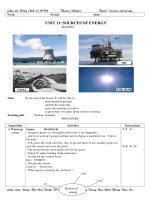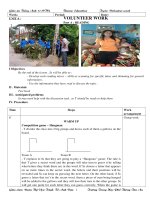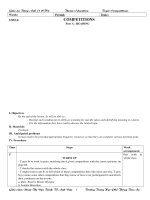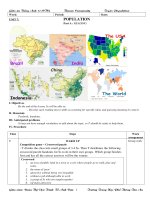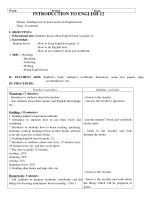- Trang chủ >>
- THPT Quốc Gia >>
- Ngoại Ngữ
unit 9 tieng anh 10 chuan
Bạn đang xem bản rút gọn của tài liệu. Xem và tải ngay bản đầy đủ của tài liệu tại đây (283.28 KB, 10 trang )
<span class='text_page_counter'>(1)</span><div class='page_container' data-page=1>
Week: Period: Date:
<b>UNIT 9: UNDERSEA WORLD</b>
<b>LESSON 1: READING</b>
<b>I. Objectives:</b>
<b> 1. Education aims: - Students read about the undersea world.</b>
2. Knowledge:
a. General knowledge: - Knowledge about the oceans and the undersea world.
b. Language: - The present simple tense.
- Vocabulary concerning undersea world like: whale, jellyfish, shark, ...
3. Skills: - Speaking : talk in pairs and in groups.
- Reading comprehension: better sts' reading skill through vocabulary Matching and
Table completion exercises.
<b>II. Anticipated problems:</b>
- Students may lack vocabulary on undersea world.
<b>III.Teaching aids: board, textbook, chalk.</b>
<b>IV. Procedures:</b>
<b> Teacher’s activities</b> <b> Students’ activities</b>
<b>1. Warm-up:( 3 mins)</b>
<i>- Aim: Sts get used to the topic. </i>
<b>+ Networks:</b>
- Sts are required to work in groups of 3 or 4 to make
a list of words related to the names of the animals in
the sea in written form.
- The group with the longest list will be the winner.
<b>2. Before you read( 12 mins)</b>
- Aim: -Prepare information and vocabularies for the
<i>topic.</i>
<i><b>+ Work with a partner 1:</b></i>
- Work in groups of 3-4 students
- Give the lists to the teacher
- Work in pairs and do the work orally.
- Some sts report.
</div>
<span class='text_page_counter'>(2)</span><div class='page_container' data-page=2>
- Ask sts to look at the map and give Vietnamese
names for the oceans on the map.
- Allow sts to discuss in pairs in 2 minutes.
- Get feedback and give remarks.
<b>+ </b><i><b>Work with a partner 2:</b></i>
- Sts are required to do in the same way as in “ work
with a partner 1” to name the sea animal in each
picture.
- Ask some sts to report.
- Listen and give remarks.
<i><b>+ Vocabulary: </b></i>
- Provide the sts with new words/phrases:
+ Gulf(n): VÞnh
+ challenge(v): tháchthức
+ Subma'rine(n): Tàu ngầm
+ 'organism(n): cá thể
+ Biodi'versity(n): sự đa dạng sinh học
+ at stake(phr) : Cã nguy c¬ tut chđng = in danger
<i>- Read each word/phrase 3 times and ask the sts to</i>
repeat it.
<i>- Leave the sts 1 minute to self-practise reading the</i>
words.
<i>- Ask 4-5 sts to read all the word/phrases aloud in</i>
front of the class
<i>- Listen and help the sts to read the words/phrases</i>
correctly.
<b>3. </b>
<b> While you read:( 20 mins)</b>
<i>- Aims: Read the passage for information to do the</i>
<i>tasks.</i>
<i><b>+ Set the scene:</b></i>
<i><b>- </b></i>You are going to read a passage about undersea
world. Read it and then do the tasks that follow.
<i><b>+ Task 1:</b>Fill in each space with a suitable from the</i>
<i>box.</i>
<i>- Ask sts to read the passage and do task 1.</i>
<i>- Sts are required to compare their results with their</i>
partners.
<i>- 5 sts are required to do the task orally in front of the</i>
class (1 st/ 1 time).
<i>- Listen and help sts to do the task correctly.</i>
<i><b>+ Task 2: </b>Answering Questions:</i>
<i>- Ask sts to work in pairs to read the passage again</i>
and answer the questions in task 2.
<i><b>- </b></i>Require sts to underline the information that
supports the answers.
- Sts are required to compare their answers with
another pair.
<i><b>- </b></i>Ask 5-6 sts to read their answers aloud in front of
the class (1 st / 1 time).
- Give correct answers.
<b>4. </b>
<b> After you read:( 9 mins)</b>
<i>- Aims: Give the summary of the passage.</i>
<i>- Sts are required to work in pairs to fill in each</i>
numbered space with a word/phrase in the box.
<i>- 8 sts represent by reading aloud the answers.</i>
<i>- Listen and help sts to do their task well.</i>
+ Pa'cific ocean: Thái bình dơng
<i>+ At'lantic ocean: Đại tây dơng</i>
<i>+ 'Indian ocean: ấn độ dơng</i>
<i>+ 'Arctic ocean: Bắc băng dơng</i>
<i>+ An'tarctic ocean ( southern ocean):</i>
<i>BiÓn nam cùc.</i>
- Listen and copy down.
- Do as they have done in the previous part
- Some sts report.
<i>+ Picture1: Seal + Picture2: Jellyfish</i>
<i>+ Picture3: Turtle + Picture4: Shark</i>
- Self- correct
- Listen and then copy down
- Listen and repeat.
- Read these words silently.
- Soms sts read these words aloud and
others listen.
- Self-correct.
- Listen to the teacher.
- Read the passage and then do the task.
- Share their answer with their partners.
- Some sts report.
<i>1. tiny 2. investigate</i>
<i>3. gulf 4. biodiversity</i>
<i>5. samples</i>
- Work in pairs to ask and answer.
- Compare their answer with other pairs.
- Some pairs report.
<i>1. 75%</i>
<i>2. They do that by using modern devices</i>
<i>3. They bring samples to the scientists to</i>
<i>study</i>
<i>4. We can learn about the temperature,</i>
<i>depth, and the marine population</i>
<i>5. They are : + the bottom depending</i>
<i> + current independing</i>
<i> + tiny organism</i>
- Work in pairs to do the task.
- 8 sts report.
<i>1. three-quarters 2. mysterious</i>
<i>3. modern 4. discovery</i>
<i>5. plants and animals 6. huge</i>
</div>
<span class='text_page_counter'>(3)</span><div class='page_container' data-page=3>
<b>5. Homework:( 1 min)</b>
- Learn the summary of the reading passage.
- Others listen
Week: Period: Date:
<b>UNIT 9: UNDERSEA WORLD</b>
<b> LESSON 2: SPEAKING</b>
<b>I. Objectives:</b>
1. Education aims: - Students know about some actions to protect the oceans.
2. Knowledge:
a. General knowledge: - Students can talk about the protection of the oceans.
b. Language: - "Should" and the simple present.
- Vocabulary on undersea world.
<b> 3. Skills:</b> - Speaking about undersea world.
- Reading and ordering the importance to protect the oceans.
<b>II. Anticipated problems:</b>
- Students may not know many new words on the topic.
<b>III. Teaching aids:</b>
Textbook, chalk, board.
IV. Procedures:
<b> Teacher’s activities</b> <b>Students’ activities</b>
<b>1. Homework - checking: (7 mins)</b>
- Ask sts to write the new words on the board.
- Ask others to answer the questions of the reading
passage.
<b>2. Before you speak: (13 mins)</b>
Aims:to focus sts on the topic and introduce the new
<i>words and phrases used to talk about the protection</i>
<i>of the oceans.</i>
<i><b>+ Task 1</b>: There are some actions that should be taken</i>
to protect our oceans. Put the actions in order of
importance and say what we should or shouldn’t do.
- Ask sts to look at the task and give sts some new
words:
<i>- rubbish (n): r¸c rëi</i>
<i>- pollute (v): gây ô nhiễm</i>
<i>- dispose (v) of sth: vứt bá</i>
<i>- 'herbicides (n): thuèc diÖt cá</i>
<i>- 'pesticide (n): thuèc trõ s©u</i>
- Ask sts to read the new words aloud.
- Ast sts to work in pairs, using should or shouldn’t to
put the actions in order of importance and talk about
these actions.
- Go around to help sts if necessary.
- T. may give sts some suggested phrases:
<i> What do you think of</i>
<i> How do you feel about + V- ing</i>
- One student write the new words on
board.
- Others answer the questions.
- Listen to the T.
- Write down the new words and practise
reading them.
- Work in pairs to do the task.
</div>
<span class='text_page_counter'>(4)</span><div class='page_container' data-page=4>
<i> What s your opinion of</i>’
<i> Well, I think...</i>
<i> In my opinion we should...</i>
- Ask some sts to give their opinions.
<b>3. While you speak( 15 mins)</b>
Aims: Sts practise discussing the consequences of the
<i>threats to the oceans and some solutions.</i>
- Ask sts to skim the sentences in Task 2 and find the
new words.
- Explain some new words:
<i> hunt (v )</i>
<i> explosive ( n)</i>
<i> spill ( v )</i>
<i> tanker ( n )</i>
-- Ask sts to work in groups of three or four to discuss
the consequences of the threat to our oceans listed in
Task 2 and offer some solutions.
- Give sts some suggestions:
Threats Consequences Solutions
<i>1. Beaches are</i>
<i>filled</i> <i>with</i>
<i>plastic bags.</i>
<i>- polluted water</i> <i>- place plastic</i>
<i>bags</i> <i>in</i>
<i>proper</i>
<i>dustbins</i>
<i>2.Whales are</i>
<i>hunted</i> <i>for</i>
<i>food.</i>
<i>-</i> <i>extinct/</i>
<i>disappear</i>
<i>- not hunt or</i>
<i>sell whale</i>
<i>products</i>
<i>3.Explosives</i>
<i>are used to</i>
<i>catch fish.</i>
<i>- a lot of fish</i>
<i>died</i>
<i>- be banned.</i>
<i>4. Oil is filled</i>
<i>from tanks</i>
<i>- polluted water</i> <i>-clean the sea</i>
<i>water/punish</i>
<i>captain.</i>
- Go around to help sts if necessary.
<b>4.After you speak: ( 9 mins)</b>
Aims: Sts report what they have discussed.
<b>Task 3: Report to the class what your group has</b>
discussed.
- Ask some representatives to report their group’s
opinions in front of the class.
- Listen and ask others to listen to give their opinions.
<b>5. Homework: (1min)</b>
- Write a passage about the threats to our oceans and
the solutions.
<i>we can know about the oceans we will</i>
<i>understand their values and try to protect</i>
<i>them.</i>
- read the sentences and find the new
words.
- Listen and take notes.
- Work in group of three or four.
- Some sts report their opinions in front of
the class.
- Others listen and give remarks.
</div>
<span class='text_page_counter'>(5)</span><div class='page_container' data-page=5>
Week: Period: Date:
<b>UNIT 9: UNDERSEA WORLD</b>
LESSON 3: LISTENING
<b>I. Objectives:</b>
<b> 1. General knowledge:</b>
- Sts know about the whales: how large they are, what they eat, where they live, and if they are
in danger.
<b> 2. Language:</b> - Parts of the world
- Vocabulary on sea animals.
<b> 3. Skills: - Listening: choose True/ False statements, answer the questions</b>
- Speaking: - Talk about whales
<b>II. Anticipated problems:</b>
- There are too many new words.
- The tape's quality is not very good.
<b>III. Teaching aids:</b>
- Textbook , tape, pictures of whales and other sea animals.
<b>IV. Procedures:</b>
<b>Teacher s activities</b>’ <b>Students activities</b>’
<b>1. Homework checking:(7 mins)</b>
One sts talks about what people should do to protect
the oceans.
<b>2. Before you listen:(10 mins)</b>
<i>Aims: to focus sts on the topic and review/</i>
<i>introduce the words and phrases used in the</i>
<i>listening text.</i>
<i><b>a</b></i>. Focus sts on the picture of a whale and ask sts to
answer the following questions:
<i> - What animal is the largest in the world?</i>
<i> - What do you know about whales?</i>
<i> - Why do people think whales are not fish?</i>
<i> - Why do people keep hunting whales?</i>
- Ask some sts to give their answer.
<i><b>b.</b></i> Introduces some new words
- 'mammal (n): the animal that raise the young
on milk
- whaling (n): hunting whales
- krill(n): tiny shellfish found in the seas (whales
feed on krill)
- mig'rate(v): to move from one place to another
according to season
- conser'vation (n): taking care of st, the
prevention of loss, damage...
- feeding / bearing ground (n): the place where a
species of animal find food/ give birth.
- an/a/the increase/ decrease in st(phr):
- International whaling Commission: an
organization responsible for the number of whales
hunted.
- measure(n): an action taken to achieve a
purpose
- Read the words and ask sts to repeat.
- Ask sts to read the words in pairs.
- Ask some sts to read the words again.
- Ask sts to refer to the map of the world in the
textbook (p. 94) and revise parts of the world, the
oceans and discuss where there are cold waters.
<b>3. While you listen:( 17 mins)</b>
<i><b>+ Task 1:</b></i>
<i>Aims: Sts practise listening and marking True/</i>
<i>False statements.</i>
One st presents. Others listen and give
remarks.
- Discuss in groups.
Some sts stand up and give their answer.
Sts copy the words and phrases.
- Listen and repeat.
- Read the words in pairs and correct each
other’s mistakes.
- Some individuals read the words aloud.
- Look at the map, recall parts of the world,
the oceans and discuss where there are cold
waters.
</div>
<span class='text_page_counter'>(6)</span><div class='page_container' data-page=6>
- Tell sts that they are going to listen to a talk about
whales.
- Ask sts to work in pairs, look at the statements
given and guess if they are true or false.
- Ask sts to listen to the talk and tick the right
column to indicate their answer and underline the
false information. T plays the tape twice.
- Ask sts to compare their answer in pairs.
- Check sts’ answer.
- Play the tape once again, stop the tape where
necessary and conduct the correction.
<i><b>+ Task 2:</b></i>
<i>Aims:Sts practise listening for specific information</i>
<i>by answering given questions.</i>
- Ask sts to have a look at the questions in the
textbook and read them in pairs and make sure they
understand them. T encourages sts guess the answer
to the questions.
- Ask sts to listen to the tape once or twice again to
answer the questions. Sts can note down important
information
- Ask sts to compare their answer in pairs.
- Check sts’ answer.
- Play the tape once again, stop the tape where
necessary and conduct the correction.
<b>4. After you listen:(10 mins)</b>
- Ask sts to work in pairs and tell each other about
the whales using the following information:
<i>largest 30 200 most intelligent cold water </i>
<i>North South Pacific Atlantic krill in danger </i>
<i>-hunting - The Eskimo - not protect - disappear.</i>
- Move round to check the activities and to make
sure that sts are working effectively.
- Ask two sts to present in front of the whole class.
- Check and give remarks.
<b>5. Homework:(1 min)</b>
Write a short paragraph about the whale
- Listen to the T.
- Work in pairs to guess if the statements are
true or false.
- Listen to the tape and do the task
- Compare their answer.
- Give their answer.
1. F. It's the largest animal on earth.
<i> 2. T 3. T</i>
<i> 4. F. They are in danger because some</i>
<i>people are still killing them for food</i>
<i> 5. T </i>
- Check their answer and then correct their
work if they have the wrong answer.
- Work in pairs to read the questions and try
to answer them.
- Listen and do the task.
- Gives their answer.
<i>1. It is about 30 metres in length and over</i>
<i>200 tons in weight.</i>
<i> 2. It is because there is a lot of krill - their</i>
<i>favourite food</i>
<i>3. They are the cold waters in the North and</i>
<i>the South of the Pacific Ocean and the</i>
<i>Atlantic Ocean.</i>
<i> 4. Heavy hunting.</i>
<i>5. They have asked the International Waling</i>
<i>Commission to stop most whaling. 6. If we</i>
<i>didn't take any measures to protect whales,</i>
<i>this kind of animal would disappear forever</i>
- Check their answer, and then correct their
work if they have the wrong answer.
- Work in pairs to talk about whales.
- Two sts present.
Week: Period: Date:
<b>UNIT 9: UNDERSEA WORLD</b>
LESSON 4: WRITING
</div>
<span class='text_page_counter'>(7)</span><div class='page_container' data-page=7>
<b>I. Objectives:</b>
<b> 1. Education Aims: - Students can write a paragraph to describe information from a table.</b>
2. Knowledge:
a. General knowledge: - Information about the sperm whale and the dolphin.
b. Language: - Language used to describe animals.
- The present simple tense.
3. Skills: - Reading: read the sample paragraph.
- Speaking: work in pairs to find information to complete the table .
- Writing: write a paragraph to describe the facts and figures provided in the table.
<b>II. Anticipated problems:</b>
- Students may have difficulty in using the information to write a full paragraph.
<b>III. Teaching Aids: - board, textbook, chalk.</b>
<b>IV. Procedures</b>:
<b> Teacher's activities</b> Students' activities
<b>1. Homework checking :( 5 mins)</b>
- Ask one st to talk about whales.
- Ask other sts to listen to their friend and give
remarks.
- Check and give remarks.
<b>2. Before you write:( 20 mins)</b>
<i>- Aims:to get sts to read the sample paragraph</i>
<i>and to help them to prepare vocabulary and</i>
<i>information before they write.</i>
<i><b>+</b><b>Task 1</b>:</i>
- Introduce the situation.
- Explain some new words:
+ sperm whale (n): a kind of whale that is hunted
for an oily substance in its head.
+ 'carnivore (n): an animal that eats meat
+ squid (n): mùc èng
+ ges'tation period (n): the process of carrying the
young baby inside the mother's body.
+ life span (n): the period from birth to death
+ en'trapment (n): sù mắc bẫy
+ 'offspring (n): con cái
- Ask sts to listen to the teacher and repeat , then
write these words into their notebooks.
- Ask sts to work in pairs to read the paragraph and
then complete the table that follows.
- Move round to help if necessary.
- Ask sts to compare their ideas with other pairs.
- Draw a table on the board and ask some sts to go
to the board and complete the table.
- Listen to their friend and give remarks.
- Listen to the teacher.
- Listen to the teacher carefully.
- Copy these words into theit notebooks.
- Listen to the teacher and then read these
words in chorus and individually.
- Read the paragraph in pairs and do the
task.
- Share their answer with their friends.
- Present their ideas.
<i>+ Range and habitat: all oceans. Prefer the</i>
<i>waters with high squid populations.</i>
</div>
<span class='text_page_counter'>(8)</span><div class='page_container' data-page=8>
- Look at the board and give remarks.
<i><b>+ Task 2:</b></i>
- Ask sts to work in pairs in 3 minutes to read the
second table with some information about the
dolphin.
- Move round to help if necessary.
<b>3. While you write:( 10 mins)</b>
- Aims: Sts practise writing a paragraph that
<i>describes the facts and figures about the dolphin..</i>
- Ask sts to use the information in the table and
write a paragraph about the dolphin basing on the
information in the table.
- Let sts write in 10 minutes.
- Move around to conduct the activity.
<b>4. After you write:( 9 mins)</b>
<i>Aims: to get feedback and check sts' work.</i>
- Get feedback by asking some sts to read their
work aloud.
- Ask some other sts to give remarks.
- Check and give the correct answer.
- If there is enough time, T can have sts exchange
their writing among sts within a group so that they
can check their friend's work and give remarks.
<b>5. Homework: ( 1min)</b>
- Part D ( page 67- workbook)
<i>+ Size: </i>
<i>Male: 18 m in length, 54,000 kg in weight</i>
<i>Female: 12 m in length, 17,000 kg in</i>
<i>weight.</i>
<i> ...</i>
- Listen to the teacher.
- Work in pairs to read the table and try to
understand the information.
- Do the writing task.
- Read their writing: ( a sample paragraph)
<i>Dolphins are not fish. They are mamals that</i>
<i>live in the water. Dolphins among the most</i>
<i>intelligent on Earth. Although they can be</i>
<i>found in all oceans in the world, dolphins</i>
<i>prefer coastal waters and bays. The size of</i>
<i>dolphins varies greatly. The smallest</i>
<i>dolphin is just about 50kg in weight and 1.2</i>
<i>metres in length while the largest o9ne can</i>
<i>weigh up to 8,200 kg and is 10 metres long.</i>
<i>Dolphins are carnivores and they eat mostly</i>
<i>fish. A female dolphin gives birth to one calf</i>
<i>every two years after a gestation period of</i>
<i>eleven to twelve months...</i>
Week: Period: Date:
<b>UNIT 9: UNDERSEA WORLD</b>
<b> LESSON 5: LANGUAGE FOCUS</b>
<b>I. Objectives:</b>
<b> 1. Education Aims:- Students know how to pronounce the sound /ɪə/, /əʊ/ and /ʊə/ correctly.</b>
- Students revise the use of "should" and conditional sentence type 2.
<b> 2. Knowledge:</b>
+ Language: - Pronunciation: /ɪə/, /əʊ/ and /ʊə/ .
- Should.
- Conditional sentence type 2.
<b> 3. Skills:</b> + Speaking: - Work in pairs to discuss the exercises.
+ Reading: - Read words and sentences aloud.
- Read the sentences silently to do the exercises.
<b>II. Anticipated problems:</b>
- Students may confuse these sounds with some sounds in Vietnamese.
<b>III. Teaching aids: - board, chalk, textbook.</b>
<b>IV. Procedures: </b>
<b> Teacher's activities</b> <b> Students' activities</b>
</div>
<span class='text_page_counter'>(9)</span><div class='page_container' data-page=9>
<b>1. Homework checking: ( 5mins)</b>
- Ask one st to read the text about the blue whale.
- Ask another st to give remarks.
- Check and give a mark.
<b>2. Pronunciation:( 10 mins)</b>
- Aims: to introduce three sounds /ɪə/<i>,</i>/eə<i>/ and /ʊə/</i>
<i>and help sts to practise these sounds.</i>
<b>a. Write three sounds on the board and pronounce</b>
them clearly twice, then ask sts to repeat.
- Tell sts how to pronounce these sounds accurately.
- Ask them to look at the textbook, listen and repeat.
- Then ask sts to work in pairs to read the words again
so that they can check for each other.
- Move around to help .
- Ask two sts to read again and give remarks.
<b>b. Ask sts to look at sentences in page 101 in the</b>
book.
- Ask them to work in pairs to read the sentences and
then find out the words containing sound /ɪə/, sound
/eə/ and sound /ʊə/ .
- Ask them to work in 2 minutes.
- Move around to conduct the activity.
- Ask one st to report and other sts to give remarks.
- Check and give the correct answers.
- Ask some sts to read these sentences aloud.
- Listen and give remarks.
<b>3. Grammar: ( 29 mins)</b>
<i> Aims: to revise the use of " should" and conditional</i>
<i>sentence type 2 and have sts do Ex1, EX 2 and EX3.</i>
<b>a. </b><i><b>Should:</b></i>
- Ask sts to tell the T the use of "should"
- Ask sts to give examples with "should" and
"shouldn't".
- Ask sts to do EX1.
+ <i><b>Exercise 1:</b></i>
- Ask sts to look at Ex1 and to do the task.
- Ask sts to do the exercise individually and then
compare their answers in pairs.
- Move round to conduct the activity.
- Check the exercise sentence by sentence.
- Listen and give remarks.
- Introduce the use of <i><b>" I think/ I don't think ...</b></i>
<i><b>should ..."</b>by using some examples:</i>
<i>eg: Joana and Andrew are planning to go skiing this</i>
<i>weekend. You think it's a bad idea.</i>
<i>You; I think you should stay at home.</i>
<i> I don't think you should go skiing thid weekend.</i>
- Explain why " I don't think ... should...." is
preferred to " I think ... shouldn't...".
- Ask sts to do EX2.
<i>+ <b>Exercise 2:</b></i>
- Ask sts to do Ex 2 individually and then share the
answers with their friends.
- Move round to help if necessary.
- Ask two sts to do this exercise on the board.
- Ask one st to give remarks.
- Check and give remarks.
- One st read the text aloud in front of the
whole class.
- Give remarks.
- Listen to the teacher.
- Write down three sounds.
- Listen to the teacher and repeat.
- Look at the book , listen and repeat.
/ɪə/ /eə/ /ʊə/
<i> here pair poor</i>
<i> dear chair sure</i>
<i> clear square tour</i>
<i> ...</i>
- Read these words in pairs and check for
their partners.
- Look at the book and work in pairs.
- Answers:
/ɪə/ /eə/ /ʊə/
beer where sure
<i> dear wear poor </i>
<i> ...</i>
- Read the sentences.
- " Should " is a modal verb that is used to
give advice.
- Some sts give examples:
eg: You should get up early in the morning.
<i> People shouldn't hunt whales.</i>
- Do Ex 1.
- Some sts sts report their work sentence by
sentence.
<i>2. You should look for another job.</i>
<i>3. He shouldn't go to bed so late.</i>
<i>4. You should take a photograph.</i>
<i>5. She shouldn't use her car so much.</i>
<i>6. He should put some pictures on the wall.</i>
- Look at the examples and listen to the
teacher.
- Listen to the teacher.
- Do this EX individually.
- Some sts report.
<i>2. I think smoking should be banned,</i>
<i>especially in restaurants.</i>
<i>3. I don't think you should go out this</i>
<i>evening.</i>
<i>4. I think he should resign.</i>
</div>
<span class='text_page_counter'>(10)</span><div class='page_container' data-page=10>
<b>b. </b><i><b>Conditional sentence type 2:</b></i>
- Review the form and the use of conditional sentence
type 2 by giving some examples:
eg: If my grandfather were still alive, he would be
<i>100 today.</i>
<i> If I had a lot of money, I would lend you some.</i>
- Ask sts to read the examples and point out the form
as well as the use of conditional sentence type 2.
+ Note: " were" is used with all persons.
- Ask some sts to give examples.
- Ask sts to do EX3.
+ <i><b>Exercise 3:</b></i>
- Ask sts to do the task in pairs.
- Go round to conduct the activity.
- Ask some pairs to read sentence by sentence.
- Listen and give remarks.
<b>5. Homework ( 1 min)</b>
- Part B ( page 54 - workbook)
- Read the examples and point out the form
and the use of conditional sentence type 2:
+ Form:
If- clause , main clause
S + V( P.S) , S + would + V
+ Use: an unreal situation at present or in
the future.
- Do Ex 3 in pairs.
- Some sts report.
<i>3. would take 7. pressed</i>
<i>4. refused 8. wouldn't be</i>
<i>5. wouldn't get 9. didn't come</i>
<i>6. closed down 10. borrowed</i>
<i> ...</i>
</div>
<!--links-->


